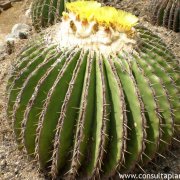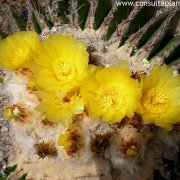Care of the cactus Ferocactus alamosanus or Echinocactus alamosanus |
|
The genus Ferocactus, family Cactaceae, comprises 30 species of large cacti native to Mexico and the southwestern United States. Some species are: Ferocactus alamosanus, Ferocactus histrix, Ferocactus latispinus, Ferocactus schwarzii, Ferocactus hamatacanthus, Ferocactus emoryi, Ferocactus x californicus, Ferocactus viridescens, Ferocactus gracilis, Ferocactus glaucescens, Ferocactus stainesii, Ferocactus peninsulae, Ferocactus cylindraceus, Ferocactus robustus, Ferocactus flavovirens, Ferocactus wislizenii. Scientific synonyms: Echinocactus alamosanus, Parrycactus alamosanus. This species is native to Chihuahua, Sinaloa and Sonora, Mexico. They are globose and solitary cacti that reach 1 meter (3.28 feet) in height and 40 cm (1.31 feet) in diameter. They have 12-20 narrow ribs with hairy oval areolas 2.5 cm (0.98") apart. They have a long, flattened central spine 6 cm long and 8 smaller radial spines (4 cm/1.57"). The flowers are deep yellow, funnel-shaped, and 3.5 cm (1.37") in diameter. They bloom in summer. They produce yellow, egg-shaped fruits. Echinocactus alamosanus is used in rockery, on sandy slopes, in cactus gardens and succulent plants and in pots for patios, terraces and greenhouses. Ferocactus alamosanus needs direct sun exposure and a warm climate. In winter the temperature should not be less than 6 ºC (42.8 ºF). Parrycactus alamosanus can grow in any type of well-drained soil: stony, poor, or sandy. Ferocactus alamosanus is a very resistant to drought plant; water moderately waiting for the substrate to dry completely. In winter do not water. Echinocactus alamosanus does not need pruning or fertilizers. Parrycactus alamosanus is a sensitive plant to excess humidity. Ferocactus alamosanus propagates by seeds sown in spring; it rarely produces suckers. |
Images of the cactus Ferocactus alamosanus or Echinocactus alamosanus |
Find plants
Ferocactus alamosanus or Echinocactus alamosanus | Care and Growing
© 2026 FavThemes

